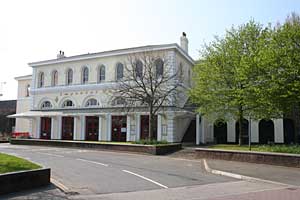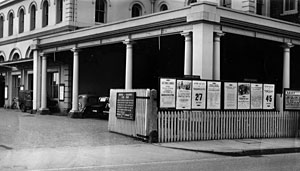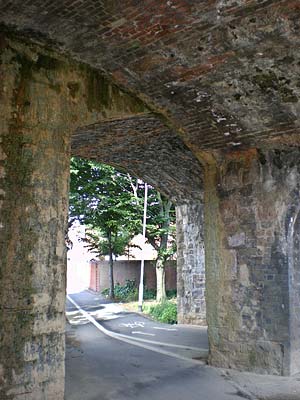
St Thomas Station - Cowick Street
Page updated 8 August 2009
Once the Bristol and Exeter Railway had reached St David's Station in May 1844, the South Devon Railway company was formed to extend the line to Plymouth and beyond. Isambard Kingdom Brunel was engaged as engineer, and he proposed that the largely untested atmospheric propulsion system be used for the line. As the railway would extend the existing line, but be a different company, there was the opportunity to create a station closer to the city which would also serve as the headquarters of the railway.
Brunel engaged Samuda & Clegg to build a 501 yard (458 metre) stone viaduct across St Thomas to carry the single broad gauge line, allowing the three roads that converged on the Exe crossing to be bridged. Where the line crossed Cowick Street was chosen as the site of the new St Thomas Station. Before the building of the station, the land was four or so feet beneath the roadway, and was described by Cossins - "commencing at the Pit to the Church. No doubt many readers are not aware of the situation of the then Pit it was the site of the present railway station, and was about four feet below the roadway consisting of an inn, blacksmith's shop, and a dwelling house, almost adjoining Beaufort House, which was originally the County Gaol."
The new station was opened on 30 May 1846, with the 175 ft (53 metre) platform flanking the eastern or down side of the single line. Between 16 August 1847 and 9 September 1848 the line was worked by the aforementioned atmospheric system. Because St Thomas Station was so close to St David's Station, where the first pumping engine was installed, trains that halted at St Thomas had to be held on their brakes while the pumping station at Exminster battled to drag the train piston along the tube. Occasionally the train would overshoot the platform, making it difficult for passengers to embark.
In 1848, 90% of the passengers on the up line, alighted at St Thomas, rather than St Davids. Suddenly, the station became an asset for any person owning a house within a short walk of the station, and the advantage was promoted when the property was put up for sale, and many adverts for lease and sale mentioned the convenience of St Thomas Station.
Up until 1862, tickets could only be purchased from St Thomas Station west, but not to St David's and north. The original station buildings were very modest, with a small booking office built at road level with steps up to the platform. A larger ticket office, a train shed over the platform to protect passengers from the weather, and an extension to the platform were completed in 1847. A small siding, to the north of the bridge, was added in 1851 for George Hennet to off load coal for the district. The Great Western Railway Staff Association club, between the viaduct and Kings now occupies the site.
A second line
The viaduct was widened in 1861 to accommodate a second track and a platform was added on the western side for the up line. A new two-storey station building was constructed on the eastern side replacing the booking offices. This is the elegant Italianate style structure that can be found today as the Imperial China Chinese restaurant. The new building contained a general and ladies waiting rooms, station masters office and toilets. A train shed that spanned both lines and platforms was built at the same time. Also on the upside a smaller, two storey building was also constructed with a waiting room and toilets.
During the Great War the station was closed due to staff shortages, between April 1917 and March 1919.In 1929 the up platform was lengthened to 220 ft (67 metres) at a cost of £835.
In 1970 the train shed and station building on the up line were taken down, during the time when Cowick Street was largely demolished and rebuilt. The land in front of the main station building became a wasteland and car park until it was redeveloped by Sainsbury's in the late 1980's.
The station is now an unstaffed halt on the main Plymouth to London line, although only for services between Exmouth and Paignton, with a few connections to London Waterloo.
 The station building is now
the Imperial China restaurant.
The station building is now
the Imperial China restaurant.
 The entrance from Cowick
Street to St Thomas Station in November 1958. Teignmouth is 2/7 (13
pence) return and Torquay 4/5 (22.5 pence).
The entrance from Cowick
Street to St Thomas Station in November 1958. Teignmouth is 2/7 (13
pence) return and Torquay 4/5 (22.5 pence).
 The two halves of the viaduct from when the single line was doubled in 1861
can be seen quite clearly in this photograph. The near arch is the
original.
The two halves of the viaduct from when the single line was doubled in 1861
can be seen quite clearly in this photograph. The near arch is the
original.
│ Top of Page │